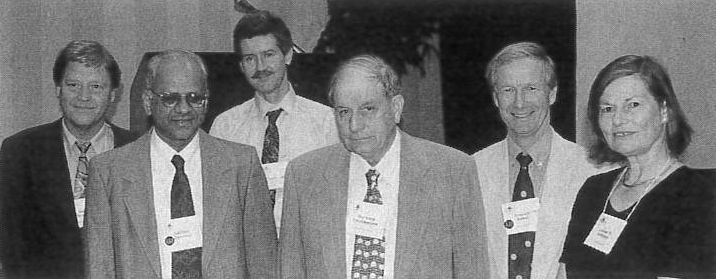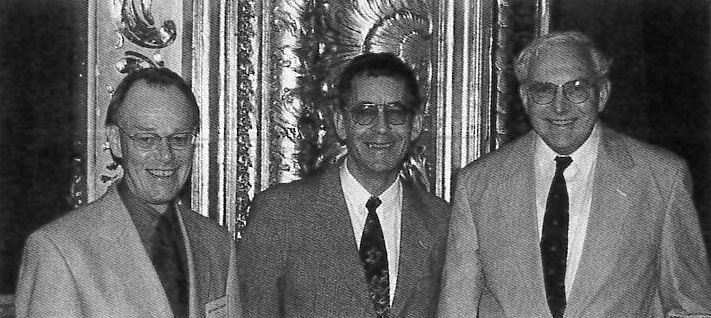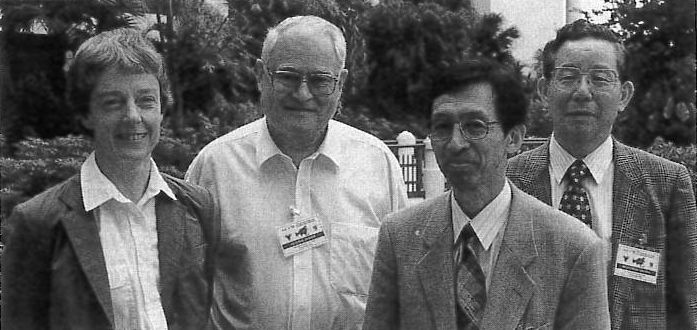
IUCr activities
50th anniversary of the IUCr
 H. Schenk, G. R. Desiraju, I. K. Robinson, D. Cruickshank, T. Baker and Louise Johnson at ACA98.
H. Schenk, G. R. Desiraju, I. K. Robinson, D. Cruickshank, T. Baker and Louise Johnson at ACA98.
IUCr President, Ted Baker, presided over the session commemorating the formation of the International Union of Crystallography at the 1998 annual meetings of the three regional affiliates of the IUCr. At the first of these sessions at the ACA meeting in Washington, D.W.J. Cruickshank presented a historical review of the formation of the Union in 1946, the first General Assembly and Congress of the IUCr held at Harvard in 1948, the publication efforts of the Union, and the roles of figures such as Paul Ewald and Robert Evans in founding the Union. Cruickshank provided statistics showing how Acta Crystallographica has grown over the years. G.R. Desiraju then gave a talk on crystal engineering and stressed the parallels between it and inorganic chemistry. Both fields require a combination of analysis and synthesis. Observing and understanding the intermolecular interactions giving rise to crystals constitutes the analytical component of crystal engineering, while the techniques used to design new solids and materials makes up the synthetic part. I.K. Robinson showed several examples of diffraction techniques applied to the study of surfaces. He presented the problems and nomenclature associated with surfaces science very effectively for members of the audience more accustomed to working with three-dimensional crystal structures. L.N. Johnson summarized crystallography's impact on biology and biochemistry. She presented several examples ranging from early studies of protein crystals to the large number of contemporary structures that have made X-ray crystallography a major component of structural biology.
 W. Hendrickson, H.-B. Bürgi, and J. White at ECM18.
W. Hendrickson, H.-B. Bürgi, and J. White at ECM18.
The second 50th anniversary session took place at ECM 18 in the Czech Republic where H.B. Bürgi's elegant talk illustrated the power of X-ray crystallography to determine the transitional, rotational and vibrational movement of molecules with high resolution, precision and accuracy and provided reliable data with which to test and extend theories of molecular structure and dynamics. J. White combined the use of neutrons and X-ray powder diffraction, optical microscopy and small angle surface diffraction techniques to obtain stunning images and detailed information concerning growing surfaces, thin films and liquid crystals. White provided examples of simple forms of life having highly reproducible extremely varied structure of complex symmetry. W. Hendrickson gave a brilliant guided tour of the short but spectacular history of macromolecular crystallography. He noted that as of 1997 there are 8,800 known protein structures and he gave a thumb nail sketch of some of the most recent, most complex and most exciting additions to the protein data bank including the nucleasome core particle, a membrane ion channel, a yeast 20S protesasome having 50,000 non hydrogen atoms, and his own study of a protein that the AIDS virus uses to attach to blood cells it infects. Finally, Hendrickson described emerging technical developments that will turn the promise of the genome project into the reality of understanding the structure and function of the thousands of unknown proteins encoded in the human, animal, insect, plant, and bacterial genomes. He predicted advances in undulator sources, CCD detectors, cryocrystallography, MAD phasing analysis and selenomethionyl protein production.
 Carol Brock, A. Janner, T. Tsukihari, and M. Tanaka at AsCa'98.
Carol Brock, A. Janner, T. Tsukihari, and M. Tanaka at AsCa'98.
At the anniversary session at the AsCA meeting in Malaysia, A. Jenner, co-recipient of the 1998 Azimov Prize, presented a remarkable analysis of the complex, multi-dimensional, mathematical and geometric symmentry patterns that he finds in the forms we see in nature ranging from snow flakes and ice crystals to viruses and membrane proteins. Everything from stain glass windows to the logo from the Atlanta ACA Meeting is seen through new eyes when you witness a lecture by Jenner. C. Brock gave a superb presentation, describing the conformational complexity of the deceptively simple biphenyl molecule. The review covered history, interdisciplinary science, theory, solid, solution, and gas state experiment and the future. X-ray results on various polymorphs and analogues of biphenyl reveal twist angles between the rings, varying from 0° to 68°. Electron diffraction studies of the twist angle in unsubstituted biphenyl consistently give an angle of 42°. Carol ended her talk with a summary of some of the latest technological advances including simultaneous refinement of multiple temperature data sets, analysis of non Bragg scattering data, ab initio structure determination for powder data, and characterization and prediction of packing patterns that should permit further analysis, interpretation and understanding of the biphenyl conundrum over the next 60 years.
T. Tsukihara gave an insightful description and analysis of the extraordinary complex and exquisitely beautiful structure of a cytochome oxidase. He sorted out the pieces of the enzyme and then assembled them like a master architect explaining in detail the two protein pathways through the enzymes that are consistent with mutation studies and function of the enzyme. Tsukihara's talent for eloquently describing the assembly of two copies of the 13 different proteins in the enzyme is as awe inpiring as the self assembly process mastered by nature over a few million years.
R. Stenkamp and W.L. Duax


